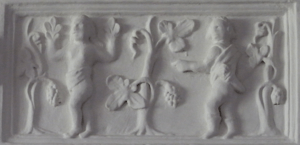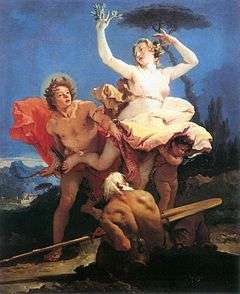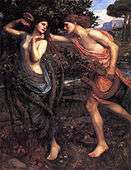Daphne
Daphne (/ˈdæfniː/; Greek: Δάφνη, meaning "laurel")[1] a minor figure in Greek mythology, is a naiad, a variety of female nymph associated with fountains, wells, springs, streams, brooks and other bodies of freshwater. She is said by ancient sources variously to have been a daughter of the river god Peneus and the nymph Creusa in Thessaly (Hyginus Fabulae 203) or of Ladon (the river Ladon in Arcadia) or Pineios, and to Ge (or Gaia) (Pausanias and others).[2] [3]
.jpg)

There are several versions of the myth in which she appears, but the general narrative appears in Greco-Roman mythology, is that due to a curse made by the god Cupid, son of Venus, on the god Apollo (Phoebus), she became the unwilling object of the infatuation of Apollo, who chased her against her wishes. Just before being kissed by him, Daphne pleaded to her river god father for help, who transformed her into a laurel tree, thus foiling Apollo.
Thenceforth Apollo developed a special reverence for laurel. At the Pythian Games which were held every four years in Delphi in honour of Apollo, a wreath of laurel gathered from the Vale of Tempe in Thessaly was given as a prize. Hence it later became customary to award prizes in the form of laurel wreaths to victorious generals, athletes, poets and musicians, worn as a chaplet on the head. The Poet Laureate is a well-known modern example of such a prize-winner, dating from the early Renaissance in Italy. According to Pausanias the reason for this was "simply and solely because the prevailing tradition has it that Apollo fell in love with the daughter of Ladon (Daphne)".[4] Most artistic depictions of the myth focus on the moment of Daphne's transformation.
Versions in mythology
The earliest source of the myth of Daphne and Apollo is Phylarchus, quoted by Parthenius. Later, the Roman poet Ovid does a retelling of this Greek legend, which appears in his work Metamorphoses.
Ovid
The pursuit of a local nymph by an Olympian god, part of the archaic adjustment of religious cult in Greece, was given an arch anecdotal turn in the Metamorphoses[5] by the Roman poet Ovid (died AD 17). According to this version Apollo's infatuation was caused by a golden-tipped arrow shot at him by Cupid, son of Venus, who wanted to punish Apollo for having insulted his archery skills by commenting "What hast thou to do with the arms of men, thou wanton boy?",[6] and to demonstrate the power of love's arrow. Eros also shot Daphne, but with a leaden-tipped arrow, the effect of which was to make her flee from Apollo.
Elated with sudden love, Apollo chased Daphne continually. He tried to make her cease her flight by saying he did not wish to hurt her. When she kept fleeing, Apollo lamented that even though he had the knowledge of medicinal herbs, he had failed to cure himself from the wound of Cupid's arrow. When Apollo finally caught up with her, Daphne prayed for help to her father, the river god Peneus of Thessaly,[7] who immediately commenced her transformation into a laurel tree (Laurus nobilis):
- "a heavy numbness seized her limbs, thin bark closed over her breast, her hair turned into leaves, her arms into branches, her feet so swift a moment ago stuck fast in slow-growing roots, her face was lost in the canopy. Only her shining beauty was left."[8]
Even this did not quench Apollo's ardour, and as he embraced the tree, he felt her heart still beating. He then declared:
- "My bride," he said, "since you can never be, at least, sweet laurel, you shall be my tree. My lure, my locks, my quiver you shall wreathe.[9]
Upon hearing his words, Daphne bends her branches, unable to stop it.
Parthenius
A version of the attempt on Daphne's sworn virginity that has been less familiar since the Renaissance was narrated by the Hellenistic poet Parthenius, in his Erotica Pathemata, "The Sorrows of Love".[10] Parthenius' tale, based on the Hellenistic historian Phylarchus, was known to Pausanias, who recounted it in his Description of Greece (2nd century AD).[11] In this, which is the earliest written account, Daphne is a mortal girl, daughter of Amyclas, fond of hunting and determined to remain a virgin; she is pursued by the boy Leucippus ("white stallion"), who disguises himself in a girl's outfit in order to join her band of huntresses. He is also successful in gaining her innocent affection. This makes Apollo angry and he puts it into the girl's mind to stop to bathe in the river Ladon; there, as all strip naked, the ruse is revealed, as in the myth of Callisto, and the affronted huntresses plunge their spears into Leucippus. At this moment Apollo's attention becomes engaged, and he begins his own pursuit. Daphne, fleeing to escape Apollo's advances, prays to Zeus to help. Zeus turns her into laurel tree. Parthenius' modern editor remarks on the rather awkward transition, linking two narratives.[12]
Laurel varieties
The name Daphne, in Greek Δάφνη, means "laurel.[13] While the story of Daphne is traditionally connected with the bay laurel (Laurus nobilis), almost 90 species of evergreen shrubs noted for their scented flowers and poisonous berries are grouped under the genus Daphne—including the garland flower (Daphne cneorum); the February Daphne or mezereon (Daphne mezereum); and spurge laurel or wood laurel (Daphne laureola). These genera are categorized in the family Thymelaeaceae and are native to Asia, Europe and North Africa
Temples
In later works
- Dafne (1598), opera by Jacopo Peri and Jacopo Corsi to a libretto by Ottavio Rinuccini
- La Dafne (1608), opera by Marco da Gagliano to a libretto Ottavio Rinuccini
- Die Dafne (1627), lost opera by Heinrich Schütz to a libretto by Martin Opitz, a translation of Rinuccini's libretto
- Daphne (1938), opera by Richard Strauss about the legend based on accounts by both Ovid and Euripides
- A famous rendition of the subject is Gian Lorenzo Bernini's sculpture Apollo and Daphne.
- Daphne's transformation in art
_Apollo_and_Daphne.jpg)

 Apollo and Daphne
Apollo and Daphne
by Waterhouse, 1908
Notes
- R. S. P. Beekes has suggested a Pre-Greek proto-form *dakw-(n)-. Daphne is etymologically related to Latin laurus, "laurel tree" (Etymological Dictionary of Greek, Brill, 2009, pp. 306–7).
- Pausanias. Description of Greece. 8.20.§1-2.
- Pausanias viii.20.1 and x.7.8; Statius, Thebaid iv.289ff; Johannes Tzetzes Ad Lycophron 6; Philostratus, Life of Apollonius of Tyana i. 16; First Vatican Mythographer ii.216; none of these citations are earlier than Parthenius' source Phylarchus.
- Pausanias. Description of Greece. 10.7.§8.
- Ovid, Metamorphoses i. 452; the treatment is commonly viewed as an Ovidian invention: see H. Fränkel, Ovid: A Poet Between Two Worlds (1945), p. 79, or E. Doblhofer, "Ovidius Urbanus: eine Studie zum Humor in Ovids Metamorphosen" Philologus 104 (1960), p. 79ff; for the episode as a witty transposition of Calvus' Io, see B. Otis, Ovid as an Epic Poet, 2nd ed., 1970, p. 102
- Translation, line 456, Loeb Classical Library
- Ovid. Metamorphoses. I:452
- "The Metamorphoses". Archived from the original on April 19, 2005. Retrieved 2017-11-17. Translation by A. S. Kline, 2000.
- Naso], Ovid [Publius Ovidius (2008-09-11), "Metamorphoses", Oxford World's Classics: Ovid: Metamorphoses, Oxford University Press, pp. 1–380, doi:10.1093/oseo/instance.00080405, ISBN 9780199537372
- J. L. Lightfoot, tr. Parthenius of Nicaea: the poetical fragments and the Erōtika pathēmata 1999, notes to XV, Περὶ Δάφνης, pp. 471ff.
- Pausanias viii.20.2.
- Lightfoot (1999), p. 471.
- R. S. P. Beekes has suggested a Pre-Greek proto-form *dakw-(n)-. Daphne is etymologically related to Latin laurus, "laurel tree" (Etymological Dictionary of Greek, Brill, 2009, pp. 306–7).
- G. Shipley, "The Extent of Spartan Territory in the Late Classical and Hellenistic Periods", The Annual of the British School at Athens, 2000.
- Pausanias, 3.24.8 (on-line text); Lilius Gregorius Gyraldus, Historiae Deorum Gentilium, Basel, 1548, Syntagma 10, is noted in this connection in Gründliches mythologisches Lexikon, Benjamin Hederich, 1770
- Karl Kerenyi, The Gods of the Greeks, 1951:141
- Built over 8th century walls and apsidal building beneath the naos, all betokening a Geometric date for the sanctuary.
- Rufus B. Richardson, "A Temple in Eretria" The American Journal of Archaeology and of the History of the Fine Arts, 10.3 (July – September 1895:326-337); Paul Auberson, Eretria. Fouilles et Recherches I, Temple d'Apollon Daphnéphoros, Architecture (Bern, 1968). See also Plutarch, Pythian Oracle, 16.
External links
| Wikimedia Commons has media related to Daphne. |
- Theoi Project: Daphne
- Apollo and Daphne – statue by Gian Lorenzo Bernini
- The Warburg Institute Iconographic Database: ca 200 images of Apollo and Daphne
- Massimo Colella, «Ti trasformasti in Dafne»: mythos ovidiano e metamorfosi nella poesia di Eugenio Montale, in «Italica (American Association of Teachers of Italian)», 96, 1, 2019, pp. 21-53.